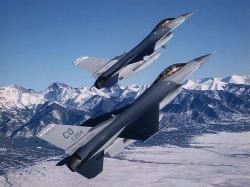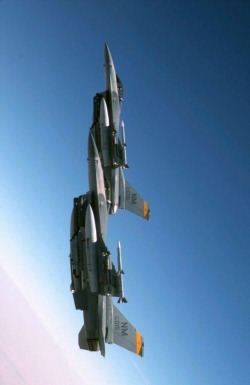| Vipers in the Storm: Keith Rosenkranz Interview
by Jeremy Wesolowski |
||||
|
Q: How complex are the Viper's weapon systems? What was, in your own personal experience, the most difficult avionics suite to master? KR: Flying the F-16 is relatively simple. It's a "pilot friendly" aircraft. Mastering the F-16's complex weapons systems is another factor. It takes the average F-16 pilot a year to a year and a half to really feel comfortable with the weapons systems. Most pilots average about 20 hours of flying per month, which equates to about 15 sorties. With that in mind, it's hard to maintain a high level of proficiency when you're only in the air three or four times per week. Another reason maintaining proficiency is difficult is the F-16's dual-role capability. When you fly a few air-to-ground sorties in a row, your bomb scores improve and you feel like things are coming together. About that time, the scheduler puts you up for a couple of air-to-air sorties. A week may pass before you fly air-to-ground again, so it's easy to see how gaining and maintaining proficiency can be difficult. In my optinion, the hardest system to master is the F-16's air-to-air radar system. The air-to-air environment is extremely dynamic. You can fly one hundred engagements and never see the same thing twice. Maintaining situational awareness in the high-speed, multi-dimensional air-to-air arena takes time and a lot of practice.
 How stable is the Viper at low altitudes? This question is assuming 550+ knots and a moderate combat load. KR: The F-16 is extremely stable at low altitude in any combat configuaration. The density of the air has a lot to do with that. For a fighter pilot, speed is life. Maneuvering at high altitude burns off energy much quicker than at low altitude. We generally fly our low levels at 300 to 500 feet, depending on the wingman's level of proficiency. The airspeed between steerpoints is 480 knots and we increase that to 540 knots for the initial point (IP) to target run. The main reason is timing. Preventing an overspeed of certain weapons and stores is another reason. |
 Mavericks. You mentioned in your book that you needed a refresher course to get familiarized with the AGM-65D. How complex of a weapon system is it? What would be the 'effective' rate-of-fire, in a single pass, that an average Viper pilot could accomplish? KR: The Maverick missile is an outstanding weapon - my favorite during the Gulf War. Employing it is hard to learn, though. Some F-16 pilots feel it is a switchology nightmare to fire it. Acquiring a target, maintaining situational awareness, and getting the Maverick off the rail can challenge even the best fighter pilots. We carried two Mavericks during each Gulf War mission. It's possible to fire two during one pass, but I always fired them on seperate passes. I think most F-16 pilots would operate the same way. Does the Viper have an IFF interrogator or does it rely on the information provided by AWACS? KR: I flew the F-16C with Block 40 avionics during the war. Our aircraft did not have IFF interogation capability. We relied on AWACS for bogey information. How effective is the RWR? Did you have any experience with the HARM during the Gulf War? KR: The F-16 radar warning receiver (RWR) is extremely effective when it comes to warning pilots of nearby enemy surface-to-air missile (SAM) and antiaircraft artillery (AAA) radar systems. An academic instructor once joked, "all the RWR does is make you tense just before you die." All joking aside, the reality is any advance warning you can receive of an impending SAM or burst of AAA will go a long way in helping you in defeat the system.I have never flown the F-16C Block 50/52 - the aircraft that carries HARMs. Go to Part III
|
|||
|
Copyright © 1997 - 2000 COMBATSIM.COM, INC. All Rights Reserved. Last Updated July 27th, 1999 |
||||
